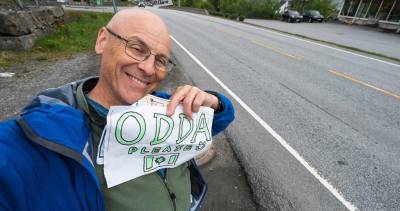Kayaking Books View Province From Water
The popularity of ocean kayaking has been a boon for B.C.'s publishers, as well as for its ecotourism outfitters, resort operators, and outdoor-gear manufacturers and retailers. Kayak how-to books and travel guides are a growth industry. The number of well-written paddling and adventure memoirs, often accompanied by exceptional imagery, is also growing. So when you consider that B.C. is widely viewed as the best kayaking destination on the planet, it seems curious no paddling guidebooks exist that methodically detail our shorelines from Tsawwassen to the Alaska border.
Most guides focus on an area of particular interest to paddlers. Thus the obvious places--Barkley, Clayoquot, and Desolation sounds; the Gulf Islands; Johnstone Strait--are well-covered. One book, Kayak Routes of the Pacific Northwest Coast (Greystone Books, revised 2004), tackles a vast area from the lower Columbia River to northern B.C. in a single volume, and does a good job, too, but necessarily only touches the highlights. An opportunity has long awaited someone seeking to produce an authoritative series for the entire coast.
Rocky Mountain Books, a division of the Heritage Group, plans to occupy that niche. The first three volumes in an ongoing project appeared earlier this year: Sea Kayak the Gulf Islands, by Mary Ann Snowden; Sea Kayak Around Vancouver Island, by Doug Alderson; and Sea Kayak Nootka & Kyuquot Sounds, by Heather Harbord. These are pocket-size guides (12.5 by 17.5 centimetres [five by seven inches]) with rounded corners to minimize damage from endless packing and unpacking. The Gulf Islands version is 160 pages long; the other two are 176 pages. Each is priced at $16.95.
The books are similar in design and structure but do not have identical formats. Each has a lengthy introduction with an overview of the area and sections on trip-planning, trip difficulty, prevailing weather and sea conditions, safety issues, land jurisdiction, wildlife, camping, and paddling etiquette. Plenty of black-and-white photos and maps are included, plus numerous short sidebars on history, flora and fauna, archaeology, and First Nations culture.
All three books deal with Vancouver Island, at least in part, and raise questions about how a series of this sort might best be organized. How large an area should each book cover? Should every cove and channel be explored? Should the books be aimed at expedition paddlers? Day-trippers? Multi-day excursionists? So far the publishers seem to be trying to satisfy everyone.
In Sea Kayak the Gulf Islands, for instance, the very competent Snowden has basically updated her previous book, Island Paddling: A Paddler's Guide to the Gulf Islands and Barkley Sound but dropped the Barkley Sound portions. Divided into eight sections, and covering the Vancouver Island coastline from Sooke almost to Nanaimo as well as the Gulf Islands, this volume describes 23 outings, from one to three days in duration, in generous detail. The author doesn't go everywhere in the region, but she does lead us to all the major attractions, and her advice, which I've found useful on numerous past occasions, is both cautious and comprehensive. This is the paddler's bible for the Gulf Islands.
Sea Kayak Around Vancouver Island offers a different approach. Alderson, author of books on kayaking techniques and safety tips, has compressed the Vancouver Island coastline, more than 3,000 kilometres, into one slender pocketbook. It's quite an achievement. His guide is organized into nine self-contained sections, as it will mostly be used by paddlers wishing to explore a specific part of the coast. It's also set up, though, to assist those few daring souls who might want to try to circumnavigate the whole thing. The disadvantage of attempting to fit so much data into such a small space is that the amount of detail is fairly meagre. Even so, Alderson manages to hit all the basics and even includes short side trips for each section of coastline.
The last book, Sea Kayak Nootka & Kyuquot Sounds, is the first paddler's guide to this part of the B.C. coast. It's also the most thorough of these works, with the best maps. Harbord, who has been paddling since 1969, outlines 49 trips in the area, divided into six sections, and examines almost every kilometre of coastline between Gold River and the Brooks Peninsula. Diarylike inserts with personal recollections help humanize the guidebook descriptions of these exposed, often dangerous waters and the wild, rugged terrain. A lot of research has gone into this small package; the result is a fine and original contribution to the kayaker's bookshelf. Harbord has also written a historical guide to the Nootka Sound area.
Heritage Group publisher Rodger Touchie explains by e-mail that the Sea Kayak series will eventually include eight to 10 books, each written by a regional expert. The next guide to appear will discuss the Sunshine Coast and Desolation Sound; in 2005, the series will move to the Lower Mainland and the Broughton Archipelago. "We are also using the series to provide support to the Georgia Strait Alliance," Touchie writes. Partial proceeds from any books purchased through the Alliance Web site (www.georgiastrait.org/) will be donated to this well-established environmental organization.















Comments